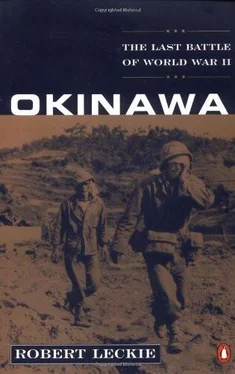There had been a ceremony. At six o’clock, all men and officers not on duty had been broken out on deck. A message from Admiral Jisaburu Ozawa, chief victim of the Americans’ “Marianas Turkey Shoot,” was read:
“Render this operation the turning point of the war.”
The men sang the somber National Anthem, “Umi Yukaba” :
Across the sea, corpses in the water,
Across the mountain, corpses in the field.
I shall die for the Emperor.
I shall never look back.
Next the ship’s company, convinced to the man that they would never survive this voyage, gave three Banzais for the emperor and returned to quarters. At ten o’clock, Yamato was in the Pacific Ocean—racing down Kyushu’s eastern shores with her consorts gathering about her, shooing the American submarine Hackleback away, swinging to starboard off Kyushu’s southern nose to sail west through Van Diemen Strait into the East China Sea.
Admiral Ito was taking the Surface Special Attack Force on a big swing west-northwest in hopes of pouncing on the Americans off Okinawa at about dusk of the next day.
But Hackleback had already alerted Admiral Spruance, and shortly before half-past eight the next morning a scout plane from Essex spotted the Japanese force just southwest of Kyushu, less than four hundred miles above Okinawa.
Patrol planes began taking off from Kerama-retto.
At ten o’clock, Yamato’s pathetic pair of fighter escorts flew back to Japan.
At ten-thirty Rear Admiral Morton Deyo was ordered to take six battleships, seven cruisers, and twenty-one destroyers north and place them between the approaching Japanese warships and the American transports. At almost the same moment the patrol planes found Yamato sailing at twenty-two knots in the middle of a diamond-shaped destroyer screen, with cruiser Yahagi trailing behind. The big planes shadowed the naked enemy fleet like vultures.
“Hope you will bring back a nice fish for breakfast,” Admiral Turner signaled Admiral Deyo.
The commander of the intercepting force seized a signal blank and pencil to write his reply. “Many thanks, will try—” An orderly handed him an intercepted message. Scouts of the Fast Carrier Forces had found the enemy. Three groups totaling 380 planes were preparing to strike. “Will try to,” Deyo concluded, “if the pelicans haven’t caught them all!”
The “pelicans” had.
At half past twelve the American warbirds were over the target. Ten minutes later two bombs exploded near Yamato’s main-mast. Another four minutes and a torpedo had pierced her side. At the same moment destroyer Hamakaze stood on her nose and slid under, and Yahagi took a bomb and a fish and went dead in the water.
There was a respite.
The Americans came again at half-past one and planted five torpedoes in Yamato’s port side. Water rushed into boiler and engine rooms, and the stricken mammoth began to lean to port. Rear Admiral Kosaku Ariga, Yamato’s captain, ordered counter-flooding in the starboard boiler and engine rooms. Ensign Mitsuru Yoshida attempted to warn the men there. Too late. They were sacrificed.
Still Yamato listed, and she had but one screw working. Her decks were a shambles of cracked and twisted steel plates. Her big guns would not work. The watertight wireless room was filled with water, and an explosion had wrecked the emergency dispensary and killed everyone inside.
At two o’clock the final attack began.
Hellcats and Avengers plunged from the skies to strike at the hapless ship. Yamato was shaken fore and aft and the entire battleship shuddered violently. Communications with the bridge were cut off, the distress flag was hoisted, the steering room became flooded, and with the rudder jammed hard left, mighty Yamato sagged over to a list of thirty-five degrees.
“Correction of list hopeless!” the executive officer cried.
Down came the Americans for the death blow.
“Hold on, men!” Ariga shouted. “Hold on, men!”
Bombs were striking around and upon Yamato, raising a giant clanging, flinging waves of roaring air across her decks, jumbling men together in heaps. Out of one pile crawled high-ranking staff officers. Admiral Ito struggled to his feet. His chief of staff arose and saluted him. The two men regarded each other solemnly. Ito turned, shook hands with each of his staff officers, wheeled, and strode into his cabin, either to embrace death or await it—the world will never know which. Admiral Ariga rushed to save the emperor’s portrait, but met death instead.
Yamato was dying slowly, like the giant she was. Her decks were nearly vertical, her battle flag all but touched the waves, explosions racked her monster body, her own ammunition began blowing up—and all around her were her sister ships in death agonies. Yahagi was sinking, Isokaze, Hamakaze, Asashimo, and Kasumo had received their death blows.
At twenty-three minutes after two Yamato slid under, a full day’s steaming from Okinawa.
Japan had lost her navy, the suicide battleship had failed, and it was now up to the kikusui and the men of Lieutenant General Mitsuru Ushijima.
Fiery Failure at Kakazu Ridge
CHAPTER ELEVEN
The honeymoon had been brief for Major General John Hodge’s Twenty-fourth Corps—hardly more than a weekend.
The day after Love Day, the Twenty-fourth’s spearheads raced across the island, Seventh Division on the left, Ninety-sixth on the right, turning to their right (or south) the next day for the anticipated rapid down-island advance. Their progress seemed as bloodless as the Marine drive in the north.
But on April 4 they found resistance “stiffening.”
It grew stiffer daily until, on April 8, “greatly increased resistance” was reported. They had come into the outerworks of Ushijima’s Naha-Shuri-Yonabaru Line, and probably its most formidable position: Kakazu Ridge.
At first glance, Kakazu (pronounced “Cock-a-zoo”) did not seem especially difficult: neither unusually high nor uncommonly steep. Three-quarters of a mile south the Urasoe-Mura Escarpment seemed a much more difficult natural barrier. That was what Colonel Eddy May thought when he prepared to send his 383rd Regiment of the Ninety-sixth Division against it. Studying Kakazu from his headquarters atop another ridge, he considered its seizure a preliminary to an assault on Urasoe-Mura. His maps suggested no other conclusion, although Colonel May was not aware that the map was probably made from photographs taken when the entire area was obscured by clouds. Kakazu was a rough coral hogback about a thousand yards long running from the coastal flats in the west on a northwest-southeast keel. It was formed by two hills of the smaller Kakazu West on May’s right flank, and the larger Kakazu Ridge proper to his left.
What Colonel May—and General Hodges—also could not suspect was that Kakazu’s defenders under Colonel Munetatsu Hara had been fortifying their position for months. Assisted by Okinawan laborers, they had constructed a subterranean honeycomb of caves, tunnels, and passageways. This would not be the first such “impregnable” position encountered by Americans in the Pacific War: what made it unique was its complete camouflage, its incredible variety and number of fortified positions, its depth, its abundance of supplies and ammunition—including a spigot-mortar unit launching huge 320 mm shells—its network of mutually supporting emplacements firing interlocking fire, and its absolute invulnerability to those nineteen-hundred-pound shells hurled at it by the battleship Colorado cruising offshore.
Читать дальше










